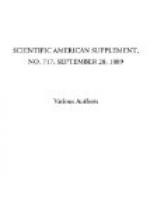* * * * *
NATURE, COMPOSITION, AND TREATMENT OF ANIMAL AND VEGETABLE FABRICS.
The inseparable duties of studying the composition of the various animal and vegetable fabrics, as also their nature—when in contact with the various mineral, vegetable, animal, and gaseous bodies applied in the individual industries—should not devolve upon the heads, chemists, or managers of firms alone. It is most important that every intelligent workman, whom we cannot expect to acquire a very extensive knowledge of chemistry and perfect acquaintance of the particular nature and component parts of fabrics, should, at least, be able to thwart the possibility of the majority of accidents brought about in regard to the quality and aspect of materials treated by them.
In the treatment of wool the first operations are of no mean importance, and the whole subsequent operations and final results, almost as a whole, depend on the manner in which the fleece washing had been effected. In presence of suintine, as also fatty matters, as well as the countless kinds of acids deposited on the wool through exudation from the body, etc., the various agents and materials cannot act and deposit as evenly as might be desired, and the complete obliteration of the former, therefore, becomes an absolute necessity.
For vegetable fabrics a great technical and practical knowledge is already requisite in their cultivation itself, and before any operations are necessary at all. One of the greatest points is the ripeness of the fibers. It is almost an impossibility to produce delicate colors on vegetable fabrics which were gathered inopportunely. Numerous experiments have been made on cotton containing smaller or larger quantities of unripe fibers, and after the necessary preceding operations, have been dyed in rose, purple, and blue colors, and the beauty of the shades invariably differed in proportion to the greater or lesser quantities of unripe fibers contained in the samples, and by a careless admixture of unripe and unseasoned fibers the most brilliant colors have been completely spoiled in the presence of the former. These deficiencies of unripe vegetable fibers are so serious that the utmost precautions should be taken, not only by planters to gather the fibers in a ripe state, but the natural aspect of ripe and unripe fibers and their respective differences should be known to the operators of the individual branches in the cotton industry themselves.
The newest vegetable fabrics, as ma (China grass), pina, abaca, or Manila hemp, agave, jute, and that obtained from the palm tree, must be tended with equal care to that of cotton. The ma, or China grass, is obtained from the Boehmeria nivea, as also from the less known Boehmeria puya. The fibers of this stalk, after preparing and bleaching, have the whiteness of snow and the




